Antique Mirrors: Antique Wall & Overmantel Mirrors
A wide and varied selection of Antique Wall Mirrors, Fireplace Overmantel Mirrors and Period Giltwood and carved Mirrors.
-
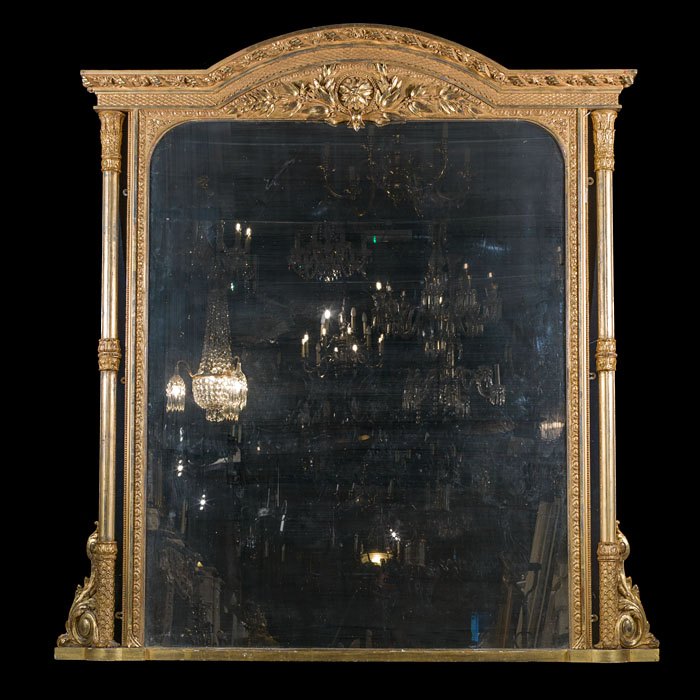 Sold
Sold
Stock: 15805
A large and fine gilt gesso overmantel mirror with an arched pediment centred by a floral rosette and laurel sprays. This is supported by two fine columns. This mirror is of excellent quality, with a sturdy panelled back.
English, c.1880.
View our collection of: Antique mirrors and console tables
|
Width |
Height |
|
|
61"
155 cms |
70 1⁄8"
178 cms |
|
|
|
|
|
-
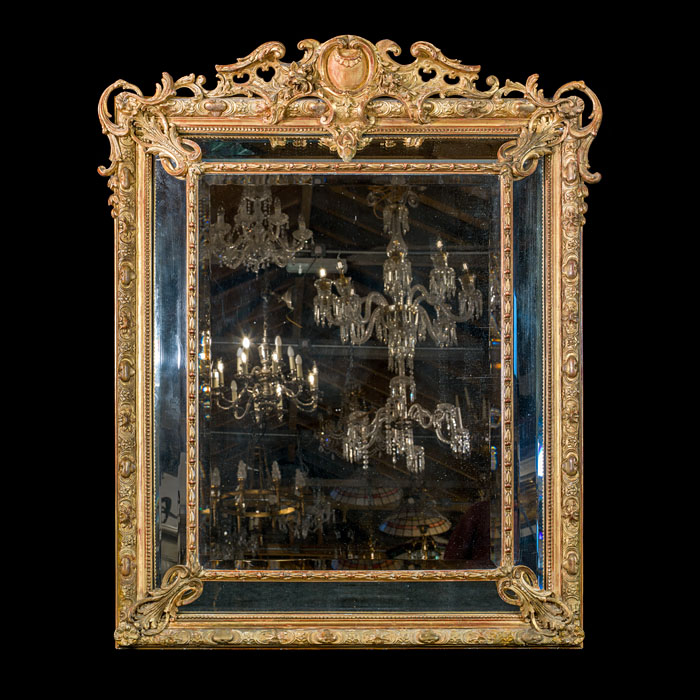 Sold
Sold
Stock: 15796
A large 19th century Baroque style gilt and gesso wall mirror, with a cushion margin comprising of four beveled plates of glass framing the large beveled central plate. The gilt gesso frame is surmounted by a cartouche set within a naturalistic broken pediment, from which emanate foliate scrolls. This detail is echoed in the foliate corners.
English, c.1860.
The frame is gilded and has its original worn finish, with the red ground showing under the gold leaf.
View our collection of: Antique mirrors and console tables
|
Width |
Height |
|
|
42 1⁄2"
108 cms |
53 7⁄8"
137 cms |
|
|
|
|
|
-
 Sold
Sold
Stock: 15762
A George III style wall mirror, its giltwood and gesso frame very much in the Chippendale manner, topped with a broken pediment surmounted by an urn. Down the side run naturalistic foliate and floral decorations. Original bevelled mirror plate.
English, c.1890.
View our collection of: Antique mirrors and console tables
|
Width |
Height |
Depth |
|
22 3⁄8"
57 cms |
40 5⁄8"
103 cms |
|
|
|
|
|
-
 Sold
Sold
Stock: 15643
A Reflection of American History -
An ornate convex mirror of grand proportions topped with an eagle on a rocky summit.
Interestingly the mirror, thought to be of American origins, is decorated with 24 spheres around the frame, whilst another sphere hangs on a chain suspended from the mouth of the eagle. This possibly symbolises the 24 established states of the USA, with the state of Arkansas represented by a ball hanging from the mouth of the eagle, the country's emblem. This shows that Arkansas joining the USA is quite literally hanging in the balance.
With this information, we can date the mirror to 1835-1836.
American, 1836. Awaiting restoration, included in the price.
View our collection of: Antique mirrors and console tables
|
Width |
Height |
|
|
23 5⁄8"
60 cms |
42 7⁄8"
109 cms |
|
|
|
|
|
-
 Sold
Sold
Stock: 15640
A grand 19th century French giltwood and gesso wall mirror or overmantel mirror in the Louis XVI style. The mirror is surmounted by a floral garland and crossed quiver and torch, either side of which are mounted flaming urns. The central mirror plate is bordered by 4 marginal plates for added decorative value. A beautiful mirror that would work as either a wall or an overmantel mirror.
French, c.1860.
View our collection of: Antique mirrors and console tables
|
Width |
Height |
|
|
37"
94 cms |
65"
165 cms |
|
|
|
|
|
-
 Sold
Sold
Stock: 15632
The Christmas Mirror.
A late 19th century carved wood and gilt gesso Gothic Revival overmantel mirror, with moulded pin reeded borders and turned finials. The mirror is crowned by a hand-painted pediment which depicts a robin perched in a sprig of holly.
English, c.1880.
View our collection of: Antique mirrors and console tables
|
Width |
Height |
Depth |
|
32 1⁄4"
82 cms |
46 1⁄8"
117 cms |
|
|
|
|
|
-
 Sold
Sold
Stock: 15617
A magnificent Louis XV Rococo gilt wall mirror of asymmetrical cartouche form, carved with a profusion of Rococo details. The mirror is surmounted by a shell and
around the frame is craved an abundance of c-scrolls, flowers and scrolling acanthus leaves. This frames the elegantly beveled mirror plate.
French, c.1890.
View our collection of: Antique mirrors
|
Width |
Height |
Width |
|
32 1⁄2"
82.5 cms |
51 5⁄8"
131 cms |
8 11⁄16"
22 cms |
|
|
|
|
-
 Sold
Sold
Stock: 15582
A grand French Louis XVI gilded overmantel mirror with a cartouche forming the crest, from which emanate sprigs of loosely ribboned laurel. The rest of the frame is decorated with a tightly bound laurel design, very much in the French tradition. The gilding has been deliberately distressed to partially reveal the warm red ground.
French, c.1880.
View our collection of: Antique mirrors
|
Width |
Height |
|
|
49 3⁄16"
125 cms |
66 7⁄8"
170 cms |
|
|
|
|
|
-
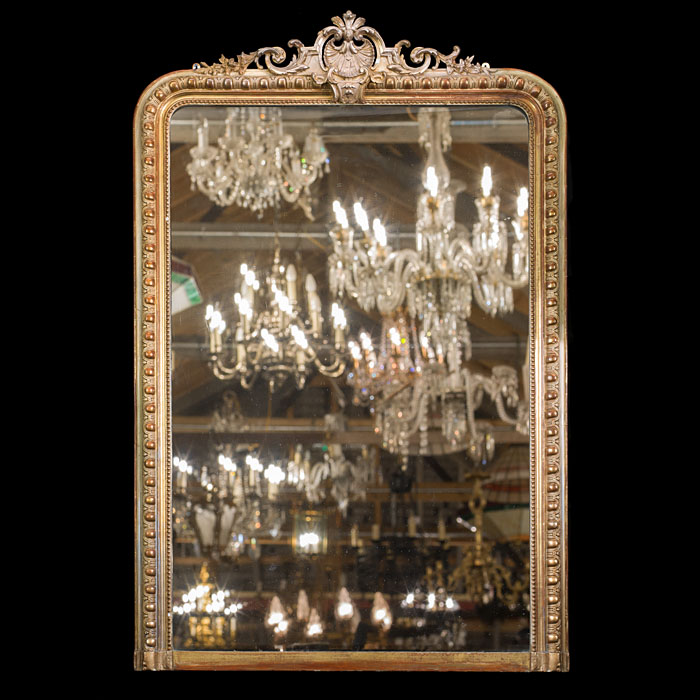 Sold
Sold
Stock: 15546
A Victorian giltwood overmantel mirror, with rounded corners and a carved surmount of Rococo form above the simple egg and dart frame. English, c.1880.
|
Width |
Height |
|
|
42 1⁄8"
107 cms |
65"
165 cms |
|
|
|
|
|
-
 Sold
Sold
Stock: 15507
An ornate Renaissance Revival French Mirror with an imposing upper crest featuring a male mask, whilst the lower cartouche features the fearsome mask of a lion. The rest of the gilt and gesso frame is similarly opulent. The central bevelled mirror is also bordered by four champagne hued pieces of handmade mirrored glass.
French, c. 1930.
View our collection of: Antique mirrors
|
Width |
Height |
|
|
38"
96.5 cms |
48"
122 cms |
|
|
|
|
|
-
 Sold
Sold
Stock: 14211
A large and ornate Louis XV style giltwood and gesso over mantel mirror, with its original mercury glass plate. It is exhuberantly and luxuriously carved throughout with abundant swags, garlands and rocaille detail and there are a pair of small cooing birds framed beneath the central arched cresting.
French, mid 19th century.
Link to: Antique mirrors and console tables
|
Width |
Height |
Depth |
|
59 1⁄8"
150 cms |
83 1⁄8"
211 cms |
6 1⁄8"
15.5 cms |
|
|
|
|
-
 Sold
Sold
Stock: 14770
A large Victorian gilt wood overmantel mirror with a high cartouche crest flanked by foliate detail and with carved rope work and paterae around the frame.
English, late 19th century.
Link to: Antique mirrors and console tables
|
Width |
Height |
Depth |
| External |
70 1⁄4"
178.5 cms |
67 11⁄16"
172 cms |
7 7⁄8"
20 cms |
|
|
|
|
-
 Sold
Sold
Stock: 15385
An attractive, arched Rococo style, giltwood wall mirror possibly an overmantel. The frame is surmounted by an ornate shell cartouche upon a bed of flowers and trailing acanthus leaves.
English, 19th century.
Link to: Antique mirrors and console tables
|
Width |
Height |
Depth |
|
30 1⁄2"
77.5 cms |
47 5⁄8"
121 cms |
7 1⁄8"
18 cms |
|
|
|
|
-
 Sold
Sold
Stock: 15386
A very pretty gilded oval wall mirror within a beaded and foliate carved frame.in the Rococo style. Florentine, late 19th century.
Link to: Antique mirrors and console tables
|
Width |
Height |
Depth |
|
27"
68.5 cms |
33 1⁄2"
85 cms |
1 3⁄8"
3.5 cms |
|
|
|
|
-
 Sold
Sold
Stock: 15357
A George III, profusely carved giltwood wall mirror in the Rococo style. The broken swan neck pediment is centred by a carved foliate crest. The scrolling, latticed frame is embellished with ornately carved flowers, fruit and acanthus leaves. English, circa 1780.
Link to: Antique mirrors and console tables
|
Width |
Height |
Depth |
|
25 5⁄8"
65 cms |
41 11⁄16"
106 cms |
2"
5 cms |
|
|
|
|
-
 Sold
Sold
Stock: 11342
A Georgian style gilded and carved mahogany overmantel mirror, with it's original plate and with carved lambs tongue motif around the frame. One of a pair with SNo 11341.
English, mid 19th century.
Link to: Antique mirrors, matching console tables
|
width |
height |
depth |
|
54 7⁄8"
139.5 cms |
45 11⁄16"
116 cms |
3 7⁄8"
10 cms |
|
|
|
|
-
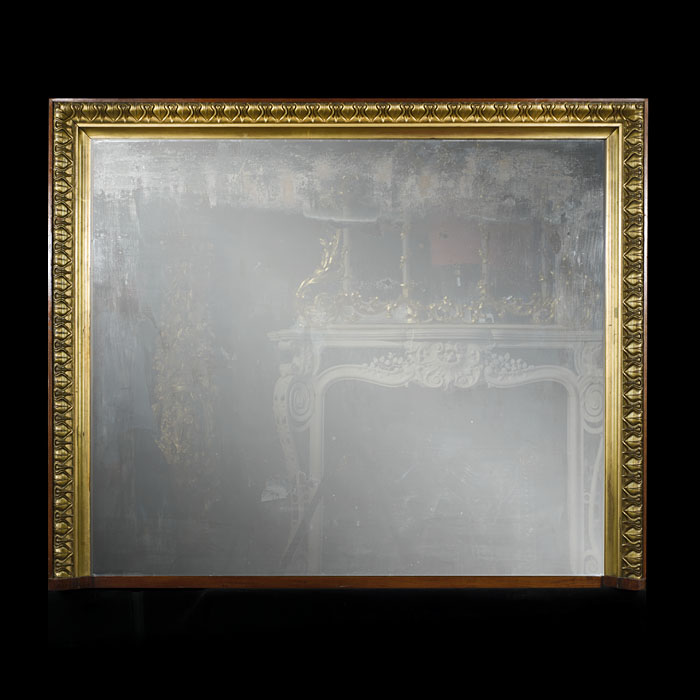 Sold
Sold
Stock: 11341
A carved giltwood, mahogany overmantel mirror in the late Georgian manner, with original plates and carved lambs tongue motif around the frame.One of a pair with SNo 11342.
English, mid 19th century.
Link to: Antique mirrors, matching console tables
|
width |
height |
depth |
|
54 7⁄8"
139.5 cms |
45 11⁄16"
116 cms |
3 7⁄8"
10 cms |
|
|
|
|
-
 Sold
Sold
Stock: 14788
A Victorian Art Nouveau walnut wall mirror. The carved foliate outer frame and tongue and dart inner frame enclosing the boxwood, burr wood and green & brown harewood classical marquetry. English, circa 1890.
Link to: Antique mirrors and console tables
|
Width |
Height |
Depth |
|
57 7⁄8"
147 cms |
43 7⁄8"
111.5 cms |
2 3⁄8"
6 cms |
|
|
|
|
-
 Sold
Sold
Stock: 14970
A finely carved early George III giltwood wall mirror in the manner of Thomas Chippendale, surmounted by a large Ho-Ho bird perched with wings outspread. The mirror with its original mercury glass also is framed by gilt acanthus scrolls, rosettes and foliate detail. The mirror has a lovely rubbed and burnished surface. English, circa.1765.
The Ho Ho bird myth originated in Japan and is similar to the phoenix. It was said to bring luck and symbolise good fortune. Carvings of these birds appeared in England in the 18th century on Georgian furniture and most commonly mounted on mirrors.
Link to: Antique mirrors and console tables
|
width |
height |
|
|
24 3⁄8"
62 cms |
48"
122 cms |
|
|
|
|
|
-
 Sold
Sold
Stock: 14969
A fine Florentine gilt wood wall mirror. The frame is exuberantly carved with acanthus leaves and scrollwork. Florentine frame-makers were and still are some of the finest in the world, and this mirror exemplifies the quality of their work. The scrolling acanthus leaves are carved in three dimensions, giving the mirror substance and depth.
Original mercury glass. Italian, mid-18th century.
Link to: Antique mirrors and console tables
|
width |
height |
Depth |
|
16 1⁄8"
41 cms |
22"
56 cms |
3 7⁄8"
10 cms |
|
|
|
|
-
 Sold
Sold
Stock: 14893
A rather delightful and very decorative 20th century wall mirror with an inset bevelled plate. The frame is embellished with a variety of broken pieces of porcelain and china in a mosaic design and is fitted with small brass candle pockets. English, mid to late 20th century.
Link to: Antique mirrors and console tables
|
width |
height |
|
|
27 5⁄8"
70 cms |
21 11⁄16"
55 cms |
|
|
|
|
|
-
 Sold
Sold
Stock: 14772
A large antique French gilt wood and gesso overmantel mirror in the Louis XV Rococo Chippendale manner with a fruit bowl crest and an inner gilt wood frame linking to the main outer elaborately carved acanthus frame.
French, late 19th century.
Link to: Antique mirrors and console tables
|
Width |
Height |
Depth |
| External |
60 3⁄16"
153 cms |
60 3⁄8"
153.5 cms |
2 13⁄16"
7 cms |
|
|
|
|
-
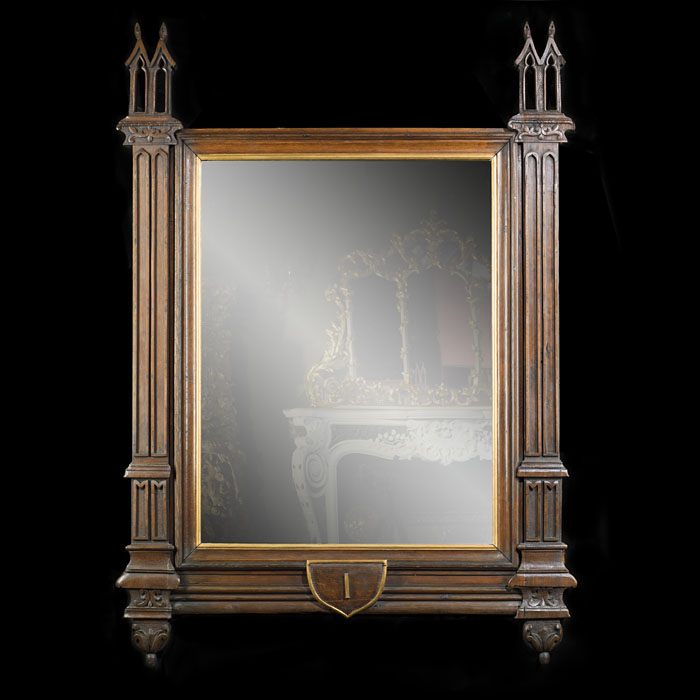 Sold
Sold
Stock: 7317
A Victorian antique oak wall mirror in the manner of A.W.N. Pugin. The moulded frame flanked by fluted pilasters with pierced double lancet finials.
English, circa 1890.
Link to: Antique mirrors and console tables
|
Width |
Height |
Depth |
|
51"
129.5 cms |
67"
170.2 cms |
2"
5.1 cms |
|
|
|
|
-
 Sold
Sold
Stock: 14771
A large ornate Louis XVI style carved gilt wood antique overmantel mirror surmounted by a cartouche and embellished with flamboyant garlands and foliate detail throughout.
French, late 19th century.
Link to: Antique mirrors and console tables
|
Width |
Height |
Depth |
| External |
47 5⁄8"
121 cms |
73 5⁄8"
187 cms |
7 1⁄8"
18 cms |
|
|
|
|
-
 Sold
Sold
Stock: 13335
An unusual, small round antique wall mirror framed in a boldly carved mahogany shield styled cartouche with fish caught in nets, game in a pouch and a large boars head mounted at the top all depicting trophies from the hunting fishing and shooting world.
English mid 19th century.
Link to: Antique mirrors and console tables
|
Width |
Height |
Depth |
|
18 1⁄8"
46 cms |
28 1⁄2"
72.5 cms |
5 7⁄8"
15 cms |
|
|
|
|
-
 Sold
Sold
Stock: 14594
A tall carved and gilded antique wall or overmantel mirror in the classical style, surmounted by a wreath, torcheres and foliate sprigs with twin descending ribboned floral swags. The carved frame with an enriched leaf border, the mirror plate with bead edging. French, late 19th century.
Photo before restoration.
Link to: Antique mirrors and console tables
|
Width |
Height |
Depth |
|
47 3⁄16"
120 cms |
78 1⁄4"
199 cms |
3 7⁄8"
10 cms |
|
|
|
|
-
 Sold
Sold
Stock: 13495
An elegant and impressive tall Louis XVI style silvered wood antique wall mirror with an elaborately carved shield cartouche cresting flanked by a pair of stylised dragons.
French, probably mid to late 19th century.
Photo before restoration.
Link to: Antique mirrors and console tables
|
Width |
Height |
Depth |
|
36 3⁄8"
92.5 cms |
64"
162.5 cms |
5 1⁄8"
13 cms |
|
|
|
|
-
 Sold
Sold
Stock: 13805
A sumptuous antique Giltwood and gesso Louis XV style Girandole mirror.
The generous pediment is in the form a single putti holding aloft garlands of summer flowers among scrolling foliage,it is set above the arched topped mirror with its original mercury glass plate. The finely detailed and moulded frame has further flamboyant foliate decoration to the bottom with two elegant scrolling single branch candle sconces.
English, mid 19th century.
Link to: Antique mirrors and console tables
|
Width |
Height |
Depth |
|
23 5⁄8"
60 cms |
63 13⁄16"
162 cms |
8 11⁄16"
22 cms |
|
|
|
|
-
 Sold
Sold
Stock: 14697
A highly ornate Rococo style giltwood antique oval wall mirror with a high stele crest above a luxuriously scrolled acanthus carved frame meeting a reversed stele crest below.
French, late 19th century.
Link to: Antique mirrors and console tables
|
Width |
Height |
Depth |
|
37"
94 cms |
61 13⁄16"
157 cms |
3 1⁄2"
9 cms |
|
|
|
|
-
 Sold
Sold
Stock: 14595
A tall an elegantly simple carved and gilded antique wall or overmantle mirror in the classical style, surmounted by a tied ribbon and floral sprig crest, the mirror plate with fine bead edging and twin floral & foliate paterae, the frame with an enriched leaf border. French, late 19th century.
Photo before restoration.
Link to: Antique mirrors and console tables
|
Width |
Height |
Depth |
| Maximum |
43 11⁄16"
111 cms |
66 7⁄8"
170 cms |
3 1⁄2"
9 cms |
|
|
|
|
-
 Sold
Sold
Stock: 14607
A large antique oak framed overmantle mirror with its original distressed plate and mounted with a central eagle and a pair of finely carved masks.
French, mid 19th century.
Link to: Antique mirrors and console tables
|
Width |
Height |
Depth |
|
78 11⁄16"
200 cms |
48 3⁄8"
123 cms |
5 7⁄8"
15 cms |
|
|
|
|
-
 Sold
Sold
Stock: 14115
A gilt pine and gesso antique overmantel mirror with an enriched carved gilt frame and bead edging around the mirror surmounted by a flamboyant clam shell crest in a bed of acanthus leaves and sprigs of flowers.
French late 19th century.
Link to: Antique mirrors and console tables
|
width |
height |
depth |
|
42 1⁄2"
108 cms |
65 3⁄8"
166 cms |
5 1⁄8"
13 cms |
|
|
|
|
-
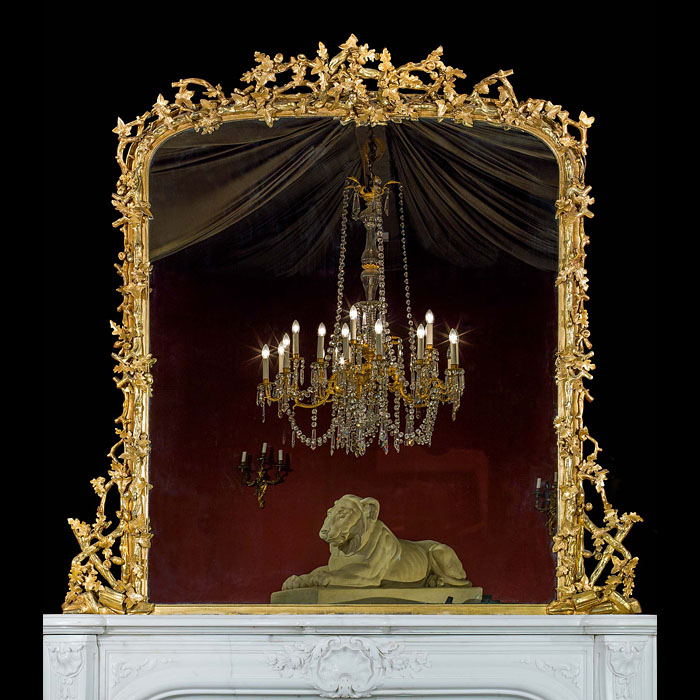 Sold
Sold
Stock: 14244
An antique gilded over mantle mirror the frame entwined throughout with applied carved oak and ivy leaf decoration
English, circa 1860.
Link to: Antique mirrors and console tables
|
Width |
Height |
Depth |
| External |
58 1⁄4"
148 cms |
60 3⁄16"
153 cms |
7 1⁄8"
18 cms |
|
|
|
|
-
 Sold
Sold
Stock: 13343
A rather beautiful and tall antique giltwood Rococo style over mantel mirror with a large and highly ornate carved Rocaille cresting and with further rocaille and acanthus decoration embellishing the frame.
English, mid 19th century.
Link to: Antique mirrors and console tables
|
Width |
Height |
|
|
47 3⁄16"
120 cms |
88 5⁄8"
225 cms |
|
|
|
|
|
-
 Sold
Sold
Stock: 14221
A giltwood and applied gesso antique overmantel mirror in the Louis XVI style with foliate cresting and finely carved and applied detail throughout.
French circa 1870.
Link to: Antique mirrors and console tables
|
width |
height |
depth |
|
49 3⁄16"
125 cms |
79 1⁄2"
202 cms |
5 1⁄2"
14 cms |
|
|
|
|
Antique mirrors
There is something alluring about an antique mirror - perhaps the combination of a finely carved frame and the shimmering surface of original glass - that has led to their enduring appeal amongst antique furniture collectors.
A short history of antique mirrors
The earliest mirrored glass was made in Murano in the 16th century, where glass was coated in mercury and tin to create a silver reflective layer on its reverse. This process was a closely guarded secret, and spies were sent from the French court of Louis XIV to Venice to discover the process. Their efforts paid off, and the French became renowned producers in their own right. Antique mirrors were made using mercury glass until other safer methods of manufacture became more widely available in the 19th century.
Earlier antique mirrors also tend to be slightly smaller, or made with separate panels of mirrored glass, as there was not the technology to produce single sheets of large glass until the late 18th century. Only the very wealthy could afford very large panes of glass, so mirrors were objects of prestige and magnificence.
Varieties of antique mirror
Whether an antique wall mirror, an overmantel mirror or a pier mirror, it is often the frame that catches the eye. Particularly fine mirrors are carved from mahogany or rosewood, or gilded using gold leaf, rather than paint. Mirror frames tend to be made of carved wood or carved wood and gesso. They are called giltwood mirrors if a thin layer of gold leaf has been applied over the carved and primed surface. Such mirrors exude quality and vary from bright gold through to a more worn, soft patina. An antique gilded mirror is often deemed more valuable than its wooden counterpart and is seen as a timeless addition to interiors of all styles.
Eras of antique mirror
Antique overmantle mirrors embody the elegance of a period home, and can inject both sophistication and character into an interior. Victorian mirrors often come in overmantel form, as in 19th century England, the mantelpiece was the heart of the home, a space to display precious objects and convey taste. The earlier Regency overmantel mirrors were often horizontal in form and more modest in design. Victorian mirrors were not only gilt, but often carved from wood such as oak, mahogany and rosewood.
In France the overmantel mirror was similarly significant, and in many cases, much taller, utilising the space above the fireplace enabled by higher ceilings and grand rooms. These Antique French mirrors are usually gilded, and wood was not widely used without a gilded adornment.
Often smaller, antique wall mirrors are an excellent thing to hang above a piece of furniture or in a hallway, where they can create the illusion of a larger, lighter space. They are less dominant than an overmantel, and serve a function in rooms such as bedrooms or hallways.
If you are looking for an overmantel or any Antique mirrors London is the place to look. Our showroom has numerous options all on display for you to browse, from early Georgian wall mirrors through to large Aesthetic movement overmantels.